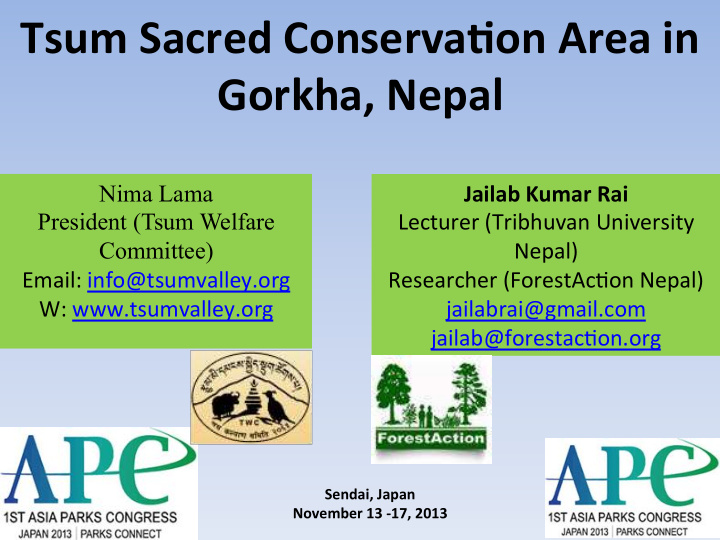



Tsum Sacred Conserva0on Area in Gorkha, Nepal Jailab Kumar Rai Nima Lama Lecturer (Tribhuvan University President (Tsum Welfare Nepal) Committee) Email: info@tsumvalley.org Researcher (ForestAcDon Nepal) W: www.tsumvalley.org jailabrai@gmail.com jailab@forestacDon.org Sendai, Japan November 13 -17, 2013
Tsum valley Within Manaslu Conservation Area • Located inside Manaslu Conservation area (declared in 1989) • Two Village Development Committees: • Chhekampar (upper Tsum) • Chumchet ( Lower Tsum) • Surrounded by beautiful mountain sites: • [Ngula Dhachhen (5093m high) in eastern direction, Thapla Pass (5,104m high ) in the western direction, Humlung Pass in the northern and Nyak in the southern direction]
Rich in Biodiversity • Surrounded by scenic beauty (mountains, waterfalls, high passes, river and lakes) • Shelter of more than 33 species of mammal (like snow leopard, musk deer, blue sheep etc). • 2000 species of plants, 11 types of forests, 3 species of reptiles. • 60 types of medicinal plants, 110 species of birds & 11 species of butterflies • All mammals are treated as friends and member of a family • The territory is like “open museum”
What is Tsum Valley for Local People? • It is sacred place; “Bheul kimolong” which means hidden valley; • Have common belief that this territory is hidden by “Guru or lord Padmasambhab”; • Tsumba people are sePler of this territory (about 500 HHs with around 3700); • Culturally rich area; • They are followers of Buddhist religion; • Lama “Serap Dorje Drukpa Rinpoche” proposed to declare upper Tsum (Chhekampar) as “Shyakya” “himsarahit chhetra” or “Non-Sacrificing area” in 1920;
Six Principles Agreed in the DeclaraDon 1. Not to kill any animals 2. Not to hunting 3. Not to harvest honey 4. Not to fire in the forest 5. Not entry for flesh traders 6. Not to trade (sell) domestic animals to the traders
Local Efforts for Expansions of Agreed Principle • Local people, leaders, Labrang Lamas agreed this proposal and d eclared this area as Non-Sacrificing territory in 1920; • Later, local people and leaders are following and preaching the concept conDnuously to new generaDons; • Series of religious preaching, celebrate fesDvals, generate local commitments by collecDng signatures to follow agreed principle; • Series of public lecture by religious priest “Lama”
Local Efforts for Expansions of Agreed Principle • Repeated commitment in 1972 • The declaration note was translated in Nepali language; • In 2009, Tsum Festival was organized and the local people repeated their commitment; • In 2012 priminister Dr Baburam Bhattarai also participated and singed on the agreement; • As result lower Tsum (Chumchet) also declared as Non-Sacrificing area in 2012
ConservaDon PracDces • Informal Practices: – Monasteries and associated local beliefs and practices (e.g. Rachhen Monastry, Piren Phu, Mu Monastry, Dephyudonma Gumba, Gumba Lungdang); – Gumba Ban (Gumba Forest) and concept and practices of no cutting of forest in the Gumba forest area; – Cultural festivals and occasional events like “Shyakya” festival – Private forest • Formal Practices: – Establishment of Buffer Zone Community Forestry (BZCF) and practices; – Implement different programs through PA authority – Establishment of local organization (e.g. Tsum Welfare Committee in 2006)
Conclusion and Lessons Learned Lessons Learned Conclusion • The culture, cultural beliefs and • Customary laws, beliefs and associated pracDces of local pracDces are more effecDve people is contribuDng to the for biodiversity conservaDon; conservaDon of biodiversity; • People living with cultural and • Religion, religious beliefs and spiritual associaDon with lands associated pracDces of local and territories posses their people are playing significant roles in the biodiversity own forms of beliefs, pracDces conservaDon; and insDtuDons; • Despite these, community leaders • IdenDficaDon, recogniDons and people are iniDaDng other and support to the customary forms of acDviDes (organize laws, beliefs and pracDces is events, occasional fesDvals, most essenDal for sustainable establish formal organizaDons conservaDon of biodiversity; etc); • Tsum people have historically • Formal PA insDtuDon such as rooted religious and spiritual BZCF are creaDng dilemmas relaDons with land and territory; and contradicDon for support to the informal or customary insDtuDons and pracDces;
Acknowledgement Support • GEF SGP (for naDonal level dialogues) • Tsum Welfare CommiPee • ForestAcDon Nepal Special Thanks • Bio-Diversity Network Japan (BDNJ) for travel and accommoda0on support
Thank You! Thank You! Thank You! Thank You!
Recommend
More recommend